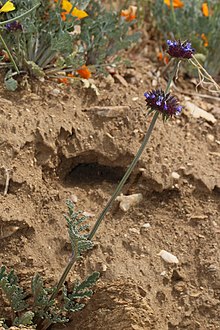Salvia columbariae
| Salvia columbariae | |
|---|---|

| |
| Scientific classification | |
| Kingdom: | Plantae |
| Clade: | Tracheophytes |
| Clade: | Angiosperms |
| Clade: | Eudicots |
| Clade: | Asterids |
| Order: | Lamiales |
| Family: | Lamiaceae |
| Genus: | Salvia |
| Species: | S. columbariae
|
| Binomial name | |
| Salvia columbariae | |
Salvia columbariae is an annual plant that is commonly called chia, chia sage, golden chia, or desert chia, because its seeds are used in the same way as those of Salvia hispanica (chia). It grows in California, Nevada, Utah, Arizona, New Mexico, Sonora, and Baja California,[2] and was an important food for Native Americans. Some native names include pashiiy from Tongva and it'epeš from Ventureño.
Description

Salvia columbariae grows 10 to 50 cm (3.9 to 19.7 in) tall. Its stem hairs are generally short and sparse in distribution. It has oblong-ovate basal leaves that are 2 to 10 cm (0.79 to 3.94 in) long. The leaves are pinnately dissected and the lobes are irregularly rounded. The inflorescence is more or less scapose, meaning it has a long peduncle that comes from the ground level that has bracts. The bracts are round and awn-tipped. There are usually 1–2 cluster of flowers within the inflorescence. The calyx is 8 to 10 mm (0.31 to 0.39 in) long and the upper lip is unlobed but has 2 (sometimes 3) awns. The lower lip is about twice the size of the upper lip. The flower color can be pale blue to blue and purple tipped. The stamens of the plant are slightly exserted. The fruit of S. columbariae is a nutlet that is tan to grey in color and 1.5 to 2 mm (0.059 to 0.079 in) long.[1]
Varieties
- Salvia columbariae var. columbariae Benth. – California sage, chia
- Salvia columbariae var. ziegleri Munz – Ziegler's sage[3]
Habitat
Salvia columbariae can be found in dry undisturbed sites, chaparral, and coastal sage scrub. It generally grows at elevations lower than 2,500 m (8,200 ft). In cultivation, it prefers good drainage, sun, and dry weather.[1]
Uses
Medicinal uses
The Cahuilla used the columbariae Benth. variety as a disinfectant by grinding the seeds to mush and applying it to infections as a poultice.[4][5] The Cahuilla, Ohlone, Kawaiisu, and Mahuna used the gelatinous seeds to cleanse out foreign matter in the eyes. The seeds were placed in the eyes for infections and inflammation, and during sleep, they were tucked underneath the eyelids to remove sand particles.[5] The Ohlone also used it to reduce fevers by consuming the seeds, and the Diegueno chewed the seeds on journeys by foot to give strength.[5]
Food
The Cahuilla, Kawaiisu, Mohave, Tohono O'odham, Chumash and Akimel O'odham grind the seeds and mixed it into water to make a thick beverage. The Cahuillas removed the alkali salts in the water, improving the flavor. They also dry the seeds to make cakes or mush. The Ohlones, Mohave, and Pomo make pinole. The Diegueno added the seeds to wheat to improve flavor. The Mahuna, Paiute, and Akimel O'odham make it into a gelatinous material, then cook it into porridge. The Luiseno, Tubatulabal, and Yavapai used it extensively as a food source.[5]
Building material
The Mahuna made it into a fiber and covered their dwellings.[5]
References
- ^ a b c "Salvia columbariae". in Jepson Flora Project (eds.) Jepson eFlora. Jepson Herbarium; University of California, Berkeley. 2018. Retrieved 2018-07-06.
- ^ Sullivan, Steven. K. (2018). "Salvia columbariae". Wildflower Search. Retrieved 2018-07-06.
- ^ Salvia columbariae. ITIS.
- ^ "Temalpakh Ethnobotanical Garden". malkimuseum.org. Archived from the original on 2008-05-15. Retrieved 2007.
{{cite web}}: Check date values in:|access-date=(help) - ^ a b c d e "Salvia columbariae Benth". herb.umd.umich.edu.
External links
 Media related to ' at Wikimedia Commons
Media related to ' at Wikimedia Commons- Calflora Database: Salvia columbariae (Chia sage)
- U.C. CalPhotos Gallery: Salvia columbariae
- NatureServe secure species
- Salvia
- Flora of Northwestern Mexico
- Flora of Arizona
- Flora of Baja California
- Flora of California
- Flora of New Mexico
- Flora of Nevada
- Flora of Utah
- Flora of Sonora
- North American desert flora
- Flora of the California desert regions
- Flora of the Sierra Nevada (U.S.)
- Natural history of the California chaparral and woodlands
- Edible nuts and seeds
- Crops originating from Pre-Columbian North America
- Plants used in Native American cuisine
- Plants used in traditional Native American medicine
- Pre-Columbian Native American cuisine
- Post-Columbian Native American cuisine
- Pre-Columbian California cuisine
- Pre-Columbian Southwest cuisine
- Annual plants
- Garden plants of North America
- Drought-tolerant plants

